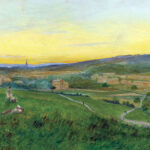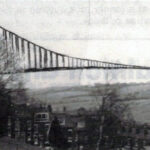9 April 1938: Huge crowds witness air-raid demonstrations on Holbeck and Woodhouse Moors, Leeds
Times. 1938/04/11. Test of Leeds Defences. London. Get it:
.Excerpt
The large crowd in the cold and darkness of Woodhouse Moor was told to imagine that “this evening we are at war.” “News has been received,” announced the commentator through loud-speakers, “that enemy aircraft have been sighted off the Yorkshire coast making for England.” Almost immediately there was the noise of a siren on a fire engine which raced round the Moor giving warning of the air raid. Guns were manned, searchlights swept the cloudy sky, and the air raid wardens. hurried to their posts in the centre of the arena. While these preparations for defence were in progress it was announced that the approaching aeroplanes were engaged in battle over York. The crowd was now tense with excitement, and in a short while the searchlights located a diminutive object among the clouds, the first of the enemy aeroplanes. Then the second was picked up. The raiders were presumed to have attacked with high explosives and incendiary bombs, and suddenly the large model of a house, specially erected in the arena, burst into flames. This gave members of the mobile first aid party and auxiliary fire squad an opportunity of showing their skill, for there were casualties, and these were rapidly treated and taken away by ambulance, while the fire squad tackled the flames. The chief feature of the other demonstration on Holbeck Moor was a mustard gas attack, the victims of which were quickly treated. Immediately the raid occurred the Intelligence Centre of the A.R.P. organization was informed by telephone and a first-aid party and decontamination squad were summoned. They soon made the mustard gas ineffective with shovels, brushes, and neutralizing compound, and then a special street washer sent jets of water over the affected spot. It did not matter to the crowd that the bomb crater on Holbeck Moor was nothing more than a 3ft. hole dug by the Leeds Highways Department.
Comment
Comment
Something to say? Get in touch
Original
TEST OF LEEDS DEFENCES
100,000 WATCH NIGHT AIR RAID
REALISTIC SCENES
FROM OUR CORRESPONDENT
LEEDS, APRIL 9
Leeds twice faced raids from the air today, each one in the spirit of make-believe. The first took place over Holbeck Moor during the afternoon, the second over Woodhouse Moor at night. The latter proved to be by far the more impressive, attracting, it is estimated, some 100,000 people, who were able to see the results of several months’ training of air raid wardens and of the 66th Anti-Aircraft Brigade, Royal Artillery, Territorial Army, which will defend Leeds in time of war.
The object of the mock raids was to give the public an opportunity of appreciating the efficiency of the defence measures and to stimulate recruiting in all branches of air raid precaution services. Aeroplanes provided by No. 609 (West Riding) (Bomber) Squadron, stationed at Yeadon, made the afternoon attack, while in the evening two civilian aeroplanes acted as the bombers.
The large crowd in the cold and darkness of Woodhouse Moor was told to imagine that “this evening we are at war.” “News has been received,” announced the commentator through loud-speakers, “that enemy aircraft have been sighted off the Yorkshire coast making for England.” Almost immediately there was the noise of a siren on a fire engine which raced round the Moor giving warning of the air raid. Guns were manned, searchlights swept the cloudy sky, and the air raid wardens. hurried to their posts in the centre of the arena.
FOUND BY SEARCHLIGHTS
While these preparations for defence were in progress it was announced that the approaching acroplanes were engaged in battle over York. The crowd was now tense with excitement, and in a short while the searchlights located a diminutive object among the clouds, the first of the enemy aeroplanes. Then the second was picked up. As the machines crossed the sky followed by the searchlights, it did not require much imagination to believe that they had done their worst with bombs in spite of the work of the anti-aircraft brigade, whose guns were reported to have damaged the aeroplanes.
The raiders were presumed to have attacked with high explosives and incendiary bombs, and suddenly the large model of a house, specially erected in the arena, burst into flames. This gave members of the mobile first aid party and auxiliary fire squad an opportunity of showing their skill, for there were casualties, and these were rapidly treated and taken away by ambulance, while the fire squad tackled the flames.
The chief feature of the other demonstration on Holbeck Moor was a mustard gas attack, the victims of which were quickly treated. Immediately the raid occurred the Intelligence Centre of the A.R.P. organization was informed by telephone and a first-aid party and decontamination squad were summoned. They soon made the mustard gas ineffective with shovels, brushes, and neutralizing compound, and then a special street washer sent jets of water over the affected spot.
It did not matter to the crowd that the bomb crater on Holbeck Moor was nothing more than a 3ft. hole dug by the Leeds Highways Department. It severed essential services and the public applauded the businesslike and confident way in which the wardens, firemen, ambulance men, and decontamination squads set about their jobs.
559 words.
Similar
 30 May 1835: Alfred Austin, future poet laureate, “Banjo-Byron that twangs the strum-strum,” is born into rural splendour at Ashwood, 48 Headingley Lane, Leeds
30 May 1835: Alfred Austin, future poet laureate, “Banjo-Byron that twangs the strum-strum,” is born into rural splendour at Ashwood, 48 Headingley Lane, Leeds 18 February 1934: Leeds Labour triggers the first rent strike against a council by announcing higher rents for well-off tenants and the prospect of free housing for ex-slum-dwellers
18 February 1934: Leeds Labour triggers the first rent strike against a council by announcing higher rents for well-off tenants and the prospect of free housing for ex-slum-dwellers Reproduction through the blind benevolence of Leeds Other Paper (RIP).1 April 1979: Amid motorway mania in Leeds, West Yorkshire Council is today to reveal plans to link Chapeltown and Woodhouse by a ¼-mile suspension bridge across Meanwood Beck
Reproduction through the blind benevolence of Leeds Other Paper (RIP).1 April 1979: Amid motorway mania in Leeds, West Yorkshire Council is today to reveal plans to link Chapeltown and Woodhouse by a ¼-mile suspension bridge across Meanwood BeckSearch
Donate
Music & books
Place-People-Play: Childcare (and the Kazookestra) on the Headingley/Weetwood borders next to Meanwood Park.
Music from and about Yorkshire by Leeds's Singing Organ-Grinder.



 Bluesky
Bluesky Extwitter
Extwitter